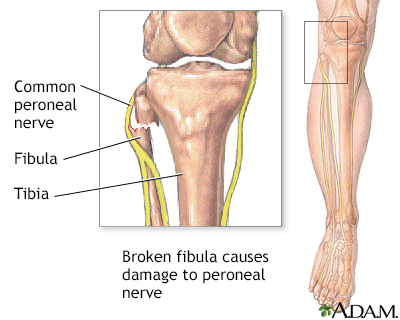Pregnancy SmartSiteTM
Common fibular nerve dysfunction; Neuropathy - common peroneal nerve; Peroneal nerve injury; Peroneal nerve palsy; Fibular neuropathy DefinitionCommon peroneal nerve dysfunction is due to damage to the peroneal nerve leading to loss of movement or sensation in the foot and leg. This condition is also called common fibular nerve dysfunction. CausesThe common peroneal nerve is a branch of the sciatic nerve. It supplies movement and sensation to the lower leg, foot and toes. Common peroneal nerve dysfunction is a type of peripheral neuropathy (nerve damage outside the brain or spinal cord). This condition can affect people of any age. Common peroneal nerve is a type of mononeuropathy. Mononeuropathy is nerve damage to a single nerve. Certain body-wide conditions can also cause single nerve injuries. Damage to the nerve disrupts the myelin sheath that covers the axon (branch of the nerve cell). The axon can also be injured, which is a more severe injury that causes similar symptoms. Common causes of damage to the common peroneal nerve include the following:
Common peroneal nerve injury is often seen in people:
SymptomsWhen the nerve is injured and results in dysfunction, symptoms may include:
Exams and TestsYour health care provider will perform a physical exam, which may show:
Tests of nerve activity include:
Other tests may be done depending on the suspected cause of nerve dysfunction, and the person's symptoms and how they develop. Tests may include blood tests, x-rays and scans. TreatmentTreatment aims to improve mobility and independence. Any illness or other cause of the neuropathy should be treated. Padding the knee may prevent further injury by crossing the legs, while also serving as a reminder to not cross your legs. In some cases, corticosteroids injected into the area may reduce swelling and pressure on the nerve. Surgery may help reduce symptoms in some cases. It may be needed:
You may need surgery if:
CONTROLLING SYMPTOMS You may need over-the-counter or prescription pain relievers to control pain. Other medicines that may be used to reduce pain include:
If your pain is severe, a pain specialist can help you explore all options for pain relief. Physical therapy exercises may help you maintain muscle strength. Orthopedic devices may improve your ability to walk and prevent contractures. These may include:
Vocational counseling, occupational therapy, or similar programs may help you stay as mobile and independent as possible. Outlook (Prognosis)The outcome depends on the cause of the problem. Successfully treating the cause may relieve the dysfunction, but it may take several months for the nerve to improve. Severe nerve damage may cause permanent disability. The nerve pain may be very uncomfortable. This disorder does not usually shorten a person's expected lifespan. Possible ComplicationsProblems that may develop with this condition include:
When to Contact a Medical ProfessionalContact your provider if you have symptoms of common peroneal nerve dysfunction. PreventionAvoid crossing your legs or putting long-term pressure on the back or side of the knee. Treat injuries to the leg or knee right away. If a cast, splint, dressing, or other pressure on the lower leg causes a tight feeling or numbness, call your provider. ReferencesKatirji B. Disorders of peripheral nerves. In: Jankovic J, Mazziotta JC, Pomeroy SL, Newman NJ, eds. Bradley and Daroff's Neurology in Clinical Practice. 8th ed. Philadelphia, PA: Elsevier; 2022:chap 106. Toro DRD, Seslija D, King JC. Fibular (peroneal) neuropathy. In: Frontera WR, Silver JK, Rizzo TD Jr, eds. Essentials of Physical Medicine and Rehabilitation: Musculoskeletal Disorders, Pain, and Rehabilitation. 4th ed. Philadelphia, PA: Elsevier; 2019:chap 75. | |
| |
Review Date: 8/28/2023 Reviewed By: Joseph V. Campellone, MD, Department of Neurology, Cooper Medical School at Rowan University, Camden, NJ. Review provided by VeriMed Healthcare Network. Also reviewed by David C. Dugdale, MD, Medical Director, Brenda Conaway, Editorial Director, and the A.D.A.M. Editorial team. The information provided herein should not be used during any medical emergency or for the diagnosis or treatment of any medical condition. A licensed medical professional should be consulted for diagnosis and treatment of any and all medical conditions. Links to other sites are provided for information only -- they do not constitute endorsements of those other sites. No warranty of any kind, either expressed or implied, is made as to the accuracy, reliability, timeliness, or correctness of any translations made by a third-party service of the information provided herein into any other language. © 1997- A.D.A.M., a business unit of Ebix, Inc. Any duplication or distribution of the information contained herein is strictly prohibited. | |

 Common peroneal ne...
Common peroneal ne...
